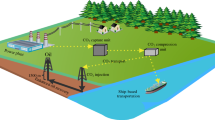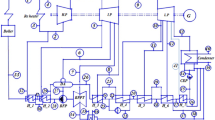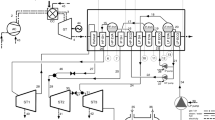Abstract
This paper presents an optimization approach for mitigating CO2 emissions in the electric power generation through integrated algae and cogeneration systems. A framework is proposed for the integration of biofixation of CO2 through the cultivation of microalgae, conversion of microalgae to biodiesel, and a steam power plant with cogeneration that is thermally coupled with an industrial facility. A systematic multi-objective optimization approach is developed to integrate the considered units while simultaneously addressing technical, economic, and environmental objectives. The solution of the optimization problem is carried out via a hierarchical decomposition approach, a genetic algorithm, and the ε-constraint method for solving the multi-objective optimization problem. A case study is considered to integrate an existing thermoelectric power station in Mexico with an algae-and-cogeneration system. The results show that important environmental, economic, and energy benefits can be achieved as a result of the proposed integration approach.






Similar content being viewed by others
Abbreviations
- C BD :
-
Unit price for biodiesel produced ($/ton)
- C bf :
-
Unit cost for biofuel bf ($/ton)
- C bm :
-
Unit cost for external biomass bm ($/ton)
- C CENTABS :
-
Concentration of algal biomass (g/L)
- C EP :
-
Unit price for electricity ($/MW)
- C f :
-
Unit cost for fossil fuel f ($/ton)
- C GLY :
-
Unit price for glycerol produced ($/ton)
- C hex :
-
Unit cost for hexane ($/ton)
- C n :
-
Unit cost for nutrient n ($/ton)
- C w :
-
Unit cost for make-up water ($/ton)
- H Y :
-
Hours of operation for the plant (h)
- H V :
-
Heating value (MJ/ton)
- K F :
-
Factor used to annualize the capital costs
- Ghge:
-
Unit greenhouse gas emissions (ton CO2 equiv./MJ)
- S GHG :
-
Unit subsidy for reduction of GHG emissions ($/ton)
- w OIL :
-
Lipid content in algal biomass (wt% of dry biomass)
- ε :
-
Parameter of the ε-constraint method
- \(\alpha_{\text{AC}}^{{{\text{CO}}_{ 2} }}\) :
-
Utilization efficiency of CO2
- \(\alpha_{\text{AH}}^{\text{CENT}}\) :
-
Recovery fraction of algal biomass in secondary harvesting (centrifugation)
- \(\alpha_{\text{AH}}^{\text{FLOC}}\) :
-
Recovery fraction of algal biomass in primary harvesting (flocculation)
- α OIL :
-
Recovery fraction of lipid in the oil extraction stage
- \(\delta_{{{\text{CO}}_{ 2} }}\) :
-
CO2 demand in kg-CO2/kg-biomass
- \(\tau_{\text{DT}}\) :
-
Fraction of the whole-day hours that feed gas is delivered to the cultivation stage
- \(\rho_{\text{SOL}}^{\text{CENT}}\) :
-
Density of the biomass slurry leaving secondary step (g/L)
- ρ W :
-
Density of liquid water (g/L)
- A heater :
-
Area of the feedwater heater (m2)
- CAP u :
-
Capital cost of each main equipment unit u ($)
- CC:
-
Annual capital cost of the system ($/year)
- E AC :
-
Power requirement for microalgae cultivation (MW/year)
- E AH :
-
Power requirement for algal biomass harvesting (MW/year)
- E BP :
-
Power requirement for biodiesel production stage (MW/year)
- E PP :
-
Power requirement for pumping of feedwater in the power plant (MW/year)
- E OE :
-
Power requirement for oil extraction stage (MW/year)
- F AC :
-
Flowrate of algal biomass produced in the cultivation stage (ton/year)
- \(F_{\text{AH}}^{\text{CENT}}\) :
-
Flowrate of algal biomass leaving secondary harvesting (centrifugation) (ton/year)
- \(F_{\text{AH}}^{\text{FLOC}}\) :
-
Flowrate of algal biomass leaving primary harvesting (flocculation) (ton/year)
- F B :
-
Flowrate entering to the deaerator (ton/year)
- F BD :
-
Flowrate of biodiesel produced (ton/year)
- F bf :
-
Flowrate of biofuel bf (ton/year)
- F bm :
-
Flowrate of biomass bm (ton/year)
- \(F_{{{\text{CO}}_{ 2} }}^{\text{acs}}\) :
-
Flowrate of CO2 sent to the algae cultivation system (ton/year)
- \(F_{{{\text{CO}}_{ 2} }}\) :
-
Flowrate of CO2 generated in the boiler of the power plant (ton/year)
- F GLY :
-
Flowrate of glycerol produced (ton/year)
- F f :
-
Flowrate of fossil fuel f (ton/year)
- F rb :
-
Flowrate of recirculated biomass bm (ton/year)
- F HEX :
-
Flowrate (consumption) of hexane (ton/year)
- F LD :
-
Flowrate of lipid-depleted algal biomass (ton/year)
- F n :
-
Flowrate (consumption) of nutrient n (ton/year)
- \(F_{{{\text{N}}_{2} }}\) :
-
Flowrate (consumption) of nitrogen (ton/year)
- F OIL :
-
Flowrate of lipid recovered from algal biomass (ton/year)
- F PH :
-
Flowrate (consumption) of phosphate (ton/year)
- F MW :
-
Flowrate (consumption) of make-up water (ton/year)
- F WLOP :
-
Water losses due to evaporation and leakages (ton/year)
- F PH :
-
Flowrate (consumption) of phosphate (ton/year)
- GHGE:
-
Greenhouse gas emissions (ton CO2 equiv./year)
- h WEV :
-
Daily evaporation depth (m/d)
- h WL :
-
Daily water loss due to leakages (m/d)
- NEP:
-
Net electric power for the integrated energy system (MW/year)
- OC:
-
Operating cost of the system ($/year)
- P w :
-
Pumping power (kW)
- PROFIT:
-
Annual gross profit ($/year)
- Q L :
-
Heat removed from the condenser (kW)
- REVENUE:
-
Revenue from the sale of electricity and bioproducts ($/year)
- TAC:
-
Total annualized cost ($/year)
- TAX CREDIT:
-
Total subsidy due to the reduction of GHGE ($/year)
- W ST :
-
Power generated by the turbine (kW)
- γ AB :
-
Algal culture productivity (g/m2 day)
- bf:
-
Biofuel
- bm:
-
Biomass
- COND:
-
Condenser
- f:
-
Fossil fuel
- n:
-
Nutrient
- NU:
-
Number of units in the system
- rb:
-
Recirculated biomass
- TURB:
-
Turbine
- u :
-
Main equipment unit
- w:
-
Water
References
Al-Azri N, Al-Thubaiti M, El-Halwagi MM (2009) An algorithmic approach to the optimization of process cogeneration. Clean Technol Environ Policy 11(3):329–338
Andiappan V, Ko AS, Lau VW, Ng LY, Ng R, Chemmangattuvalappil NG, Ng DK (2015) Synthesis of sustainable integrated biorefinery via reaction pathway synthesis: economic, incremental environmental burden and energy assessment with multiobjective optimization. AIChE J 61(1):132–146
Bamufleh HS, Ponce-Ortega JM, El-Halwagi MM (2013) Multi-objective optimization of process cogeneration systems with economic, environmental, and social tradeoffs. Clean Technol Environ Policy 15:185–197
Bartela L, Skorek-Osikowska A, Kotowicz J (2014) Thermodynamic, ecological and economic aspects of the use of the gas turbine for heat supply to the stripping process in a supercritical CHP plant integrated with a carbon capture installation. Energy Convers Manag 85:750–763
Brune DE, Lundquist TJ, Benemann JR (2009) Microalgal biomass for greenhouse gas reductions: potential for replacement of fossil fuels and animal feeds. J Environ Eng 135:1136–1144
Bruno JC, Fernandez F, Castells F, Grossmann IE (1998) A rigorous MINLP model for the optimal synthesis and operation of utility plants. Chem Eng Res Des 76:246–258
Cau G, Cocco D, Tola V (2014) Performance assessment of USC power plants integrated with CCS and concentrating solar collectors. Energy Convers Manag 88:973–984
Diwekar UM (2003) Introduction to applied optimization. Kluwer, Dordrecht
DOE (2015) Fuel prices. http://www.afdc.energy.gov/fuels/prices.html. Accessed Jan 2015
El-Halwagi MM (1997) Pollution prevention through process integration: systematic design tools. Academic Press, San Diego
El-Halwagi MM (2006) Process integration. Elsevier, Amsterdam
El-Halwagi MM (2012) Sustainable design through process integration: fundamentals and applications to industrial pollution prevention, resource conservation, and profitability enhancement. Butterworth-Heinemann/Elsevier, London
Farrelly DJ, Everard CD, Fagan CC, McDonell KP (2013) Carbon sequestration and the role of biological carbon mitigation: a review. Renew Sustain Energy Rev 21:712–727
Gebreslassie BH, Waymire R, You F (2013) Sustainable design and synthesis of algae-based biorefinery for simultaneous hydrocarbon biofuel production and carbon sequestration. AIChE J 59:1599–1621
Goldberg DE (1989) Genetic algorithms in search, optimization, and machine learning. Addison-Wesley, Reading
Gong J, You F (2014) Optimal design and synthesis of algal biorefinery processes for biological carbon sequestration and utilization with zero direct greenhouse gas emissions: MINLP model and global optimization algorithm. Ind Eng Chem Res 53(4):1563–1579
Goyal R, Sharma D, Soni SL, Gupta PK, Johar D (2015) An experimental investigation of CI engine operated micro-cogeneration system for power and space cooling. Energy Convers Manag 89:63–70
Gutiérrez-Arriaga CG, Serna-González M, Ponce-Ortega JM, El-Halwagi MM (2013) Multi-objective optimization of steam power plants for sustainable generation of electricity. Clean Technol Environ Policy 15:551–566
Gutiérrez-Arriaga CG, Serna-González M, Ponce-Ortega JM, El-Halwagi MM (2014) Sustainable integration of algal biodiesel production with steam electric power plants for greenhouse gas mitigation. ACS Sustain Chem Eng 2(6):1388–1403
Habka M, Ajib S (2014) Studying effect of heating plant parameters on performances of a geothermal-fuelled series cogeneration plant based on Organic Rankine Cycle. Energy Convers Manag 78:324–337
Harun R, Singh M, Forde GM, Danquah MK (2010) Bioprocess engineering of microalgae to produce a variety of consumer products. Renew Sustain Energy Rev 14(3):1037–1047
IEA (2008) CO2 emissions from fuel combustion: 1971/2006, vol 21. International Energy Agency, Paris, pp 1–530
IEA (2010) World energy outlook, vol 21. International Energy Agency, Paris, pp 1–530
IPCC (2007) Climate change 2007: the physical science basis. Cambridge University Press, Cambridge
Jenni KE, Baker ED, Nemet GF (2013) Expert elicitations of energy penalties for carbon capture technologies. Int J Greenh Gas Control 12:136–145
Kelloway A, Daoutidis P (2014) Process synthesis of biorefineries: optimization of biomass conversion to fuels and chemicals. Ind Eng Chem Res 53(13):5261–5273
Kemp I (2009) Pinch analysis and process integration—a user guide on process integration for the efficient use of energy, 2nd edn. Butterworth-Heinemann, Amsterdam
Li S, Jin H, Gao L, Zhang X, Ji X (2014) Techno-economic performance and cost reduction potential for the substitute/synthetic natural gas and power cogeneration plant with CO2 capture. Energy Convers Manag 85:875–887
Moran MJ, Shapiro HN (2006) Fundamentals of engineering thermodynamics. John Wiley & Sons, London, United Kingdom
Ng RTL, Hassim MH, Ng DKS (2013) Process synthesis and optimization of a sustainable integrated biorefinery via fuzzy optimisation. AIChE J 59:4212–4227
Noureldin MMB, Bao B, Elbashir NO, El-Halwagi MM (2014) Benchmarking, insights, and potential for improvement of Fischer–Tropsch-based biomass-to-liquid technology. Clean Technol Environ Policy 16:37–44
Pokoo-Aikins G, Nadim A, El-Halwagi MM, Mahalec V (2010) Design and analysis of biodiesel production from algae grown through carbon sequestration. Clean Technol Environ Policy 12:239–254
Rao AB, Rubin ES (2002) A technical, economic, and environmental assessment of amine-based CO2 capture technology for power plant greenhouse gas control. Environ Sci Technol 36:4467–4475
Rickman M, Pellegrino J, Hock J, Shaw S, Freeman B (2013) Life-cycle and techno-economic analysis of utility-connected algae systems. Algal Res 2:59–65
Rizwan M, Lee JH, Gani R (2013) Optimal processing pathway for the production of biodiesel from microalgal biomass: a superstructure based approach. Comput Chem Eng 58:305–314
Rubin ES, Zhai H (2012) The cost of carbon capture and storage for natural gas combined cycle power plants. Environ Sci Technol 46:3076–3084
Rubin ES, Chen C, Rao AB (2007) Cost and performance of fossil fuel power plants with CO2 capture and storage. Energy Policy 35:4444–4454
SENER-CONUEE (2009) Methodologies for quantifying greenhouse gases emissions and energetic consumptions avoided by the sustainable use of energy. Mexican Ministry of Energy, Mexico City
Sheppard MC, Socolow RH (2007) Sustaining fossil fuel use in a carbon constrained world by rapid commercialization of carbon capture and sequestration. AIChE J 53:3022–3028
Solomon S, Qin D, Manning M, Chen Z. Marquis M, Averyt KB, Tignor M, Miller HL (2007) Climate change: the physical science basis. Contribution of working group I to the fourth assessment report of the intergovernmental panel on climate change. Cambridge University Press, New York
Soltani R, Mohammadzadeh Keleshtery P, Vahdati M, KhoshgoftarManesh MH, Rosen MA, Amidpour M (2014) Multi-objective optimization of a solar-hybrid cogeneration cycle: application to CGAM problem. Energy Convers Manag 81:60–71
Stauffer PH, Keating GN, Middleton RS, Viswanathan HS, Berchtold KA, Singh RP, Pawar RJ, Mancino A (2011) Greening coal: breakthroughs and challenges in carbon capture and storage. Environ Sci Technol 45:8597–8604
Tredici MR (2010) Photobiology of microalgae mass cultures: understanding the tools for the next green revolution. Biofuels 1:143–162
Ventura JRS, Yang B, Lee YW, Lee K, Jahng D (2013) Life cycle analyses of CO2, energy and cost for four different routes of microalgal bioenergy conversion. Bioresour Technol 137:302–310
Wagner W, Cooper JR, Dittmann A, Kijima J, Krestzschmar HJ, Kruse A, Mares R, Oguchi K, Sato H, Stocker I (2000) The IAPWS industrial formulation 1997 for the thermodynamic properties of water and steam. J Eng Gas Turbine Power 122:150–182
Wang L, Yang Y, Shen W, Kong X, Li P, Yu J, Rodrigues AE (2013) CO2 capture from flue gas in an existing coal-fired power plant by two successive pilot-scale VPSA units. Ind Eng Chem Res 52:7947–7955
Yuan Z, Chen B, Gani R (2013) Applications of process synthesis: moving from conventional chemical processes towards biorefinery processes. Comput Chem Eng 49:217–229
Acknowledgments
The authors acknowledge the financial support from the Mexican Council for Science and Technology (CONACyT) and the Council for Scientific Research of the Universidad Michoacana de San Nicolás de Hidalgo. Also this project was funded by the Deanship of Scientific Research (DSR) at King Abdulaziz University, Jeddah, under Grant No. 3-34/RG. Therefore, the authors acknowledge with thanks DSR technical and financial support.
Author information
Authors and Affiliations
Corresponding author
Electronic supplementary material
Below is the link to the electronic supplementary material.
Appendix 1: Algae-to-biodiesel production model
Appendix 1: Algae-to-biodiesel production model
This appendix presents the model for the algae cultivation system, which produces biodiesel and glycerol. This model is described as follows.
The algal biomass (F AC) produced in the cultivation stage is computed as follows:
where \(\alpha_{\text{AC}}^{{{\text{CO}}_{ 2} }}\) is the efficiency of CO2 transfer into the algal growth medium, \(\delta_{{{\text{CO}}_{ 2} }}\) is the CO2 demand in kg-CO2/kg-biomass, τ DT is the fraction of the whole-day hours that CO2 from the power plant (feed gas) is delivered to the cultivation stage, and \(F_{{{\text{FCO}}_{ 2} }}\) is the flowrate of CO2 generated by the power plant boiler.
Also, the feed gas delivery is carried out only during the day, so τ DT = 0.5. Thus, the mass balance equations for algal biomass in both harvesting steps are expressed as follows:
where \(\alpha_{\text{AH}}^{\text{FLOC}}\) and \(\alpha_{\text{AH}}^{\text{CENT}}\) are the recovery fractions of algal biomass in primary and secondary harvesting, respectively; \(F_{\text{AH}}^{\text{FLOC}}\) and \(F_{\text{AH}}^{\text{CENT}}\) represent the algal biomass flowrates leaving the flocculation and centrifugation operations, respectively.
In the oil extraction stage, the amount of recovered triglycerides (F OIL) from algal biomass is
where α OIL is the recovery fraction of oil using n-hexane as solvent and w OIL is the lipid content in algal biomass (wt% of dry biomass).
The consumption of fresh hexane for oil extraction is calculated as follows:
The lipid-depleted algal biomass or residual biomass (F LD) generated by the extraction operation is obtained by the following relationship:
Combining Eqs. (14), (15), (16), and (18), the following relationship is obtained:
with
The biodiesel (F BD) and glycerol (F GLY) produced in the final stage of the system are determined as follows:
Equations (14), (15), (16), and (22) give a simple expression for biodiesel produced in terms of the variable \(F_{{{\text{FCO}}_{ 2} }}\):
The nitrogen and phosphate requirements for microalgae cultivation can be computed from the following equations:
The water losses due to evaporation and leakages (F WLOP in ton/year) can be expressed as
where h WEV is the daily evaporation depth (m/day), h WL is daily water loss due to leakages (m/day), and γ AB is the algal culture productivity (g/m2 day). In Eq. (27), 1 × 106 is the conversion factor between g and ton.
After the secondary harvesting step, all the water presents in the outlet stream (F WLC) that is directed to the dryer is also lost. This water loss is calculated as follows:
where \(\rho_{\text{SOL}}^{\text{CENT}}\) is the density of the biomass slurry leaving the secondary step and \(C_{\text{ABS}}^{\text{CENT}}\) is the concentration of algal biomass in that stream. This equation can be rearranged to another useful form:
To obtain this equation, \(C_{\text{ABS}}^{\text{CENT}}\) = 150 g/L53 and \(\rho_{\text{SOL}}^{\text{CENT}}\) = 1000 g/L.
Thus, the amount of make-up water that must be added to the algae-to-biodiesel process to compensate for the loss of water can be expressed as
where ρ W is the density of liquid water.
The annual net electric power for the integrated energy system is given as the difference between the electric power generated by the power plant and that consumed by the algae-to-biodiesel subsystem:
where E AC, E AH, E OE, E BP, and E PP are the annual electricity requirements for microalgae cultivation, algal biomass harvesting, oil extraction, biodiesel production, and pumping of feedwater in the power plant, respectively (see Fig. 2). The energy consumptions for the stages of the algae-to-biodiesel system were calculated using the data shown in Table 1.
Rights and permissions
About this article
Cite this article
Lira-Barragán, L.F., Gutiérrez-Arriaga, C.G., Bamufleh, H.S. et al. Reduction of greenhouse gas emissions from steam power plants through optimal integration with algae and cogeneration systems. Clean Techn Environ Policy 17, 2401–2415 (2015). https://doi.org/10.1007/s10098-015-0982-1
Received:
Accepted:
Published:
Issue Date:
DOI: https://doi.org/10.1007/s10098-015-0982-1




